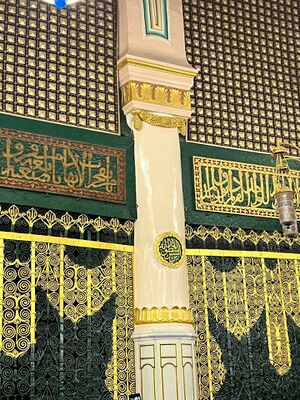Al-Sarir pillar
Al-Sarīr pillar is one of the pillars of Masjid al-Nabi, which was the place of Prophet's Iʿtikāf . This pillar was used as the pillars of the Prophet's shrine during the reconstruction of Masjid al-Nabi by Baybars Mamluki, and since then it has been removed from the reach of pilgrims to seek blessings. According to traditions, it is recommended to seek blessing this pillar.
 | |
| General Information | |
|---|---|
| Other Names | pillar of I'tikaf |
| Place | Medina, Masjid al-Nabi |
| History | |
| Events | Prophet would spread his bed next to this pillar during I'tikaf.. |
| Current State | |
| Status | The Sarir pillar is located on the eastern side of the al-tawba pillar, and the first pillar from the Qibla and connected to the western wall of the Prophet's Room. This pillar was not accessible to pilgrims since the time of Baybaras. |
Location
The Sarir pillar is located in Masjid al-Nabi, in the area of Rawdat al-Nabi, on the east side of the pillar of repentance[1] and the first pillar from the Qibla direction and connected to the western wall of the Prophet's shrine.[2]
Reason for naming
The Sarir pillar is called by this name because during the days of I'tikaf, the Prophet used to place his bed which was made of palm leaves and wood or mat,[3] and would perform I'tikaf and calm down on it when the time of resting.[4]
Is Sarir pillar the same as Al-Tawba pillar?!
The local historians of Madina, such as Ibn Zabala, Ibn Najjar and Matari, did not introduce the Sarir pillar. They have only mentioned that during the I'tikaf days of the month of Ramadan, the bed of the prophet was placed between the pillar of repentance and the lamp near the prophet's grave[5] or near the pillar of repentance[6] or behind it from the east.[7] Therefore, Some have considered the pillar of Sarir as the pillar of repentance.[8]
But it is true that the bed of the prophet was sometimes next to the pillar of repentance and sometimes next to the pillar of sarir.[9] Ayub Sabri Pasha and Ahmad bin Abdul Hamid believe that before the development of Masjid al-Nabi, which was carried out after the Battle of Khaybar, the Prophet's I'tikaf was next to The pillar of repentance and then it was moved to the side of the pillar of Sarir.[10]
Status
After half of the Sarir pillar was placed inside the prophet's shrine[11] during the reconstruction of Masjid al-Nabi during the reign of Malik Zahir Baibaras (R: 825-842 AH/ 1422- 1438-9) of the Mamluks of Egypt,[12] it is not possible for pilgrims to bless it.
Virtues
On the sarir pillar, the phrase " «هذه اسطوانة السریر» This is the pillar of sarir" is written[13] and based on some hadiths, it is recommended to bless it.[14]
Gallary
-
The map of Masjid al-Nabi where number 2 shows the location of the Sarir pillar.
-
Sarir pillarnext to Haras pillar.
-
The image taken from the direction of the Qiblah shows the Serir Pillar and the Al-Tawba pillar.
-
The inscription engraved on the top of the Sarir pillar: «هذه استوانة سریر» "This is the pillar of Sarir".
Notes
- ↑ Samhūdī, Wafāʾ al-wafā, vol. 2, p. 184; Shurrāb, Al-Ma ʿālim al-athīra, p. 40.
- ↑ Qāʾidān, Tārīkh wa āthār-i Islāmī-i Makka wa Madīna, p. 193.
- ↑ Ibn Zabāla, Akhbār al-madīna, p. 103; Maṭarī, Al-Taʿrīf bimā ʾanasat, p. 91; Najjār, Al-Durra al-thamīna, p. 298.
- ↑ Sayyid al-Wakīl, Al-masjid al-nabawīī ʿabar tārīkh, p. 53; Yamānī, Mawsūʿa makka al-mukarrama wa al-madina al-munawwara, vol. 2, p. 430.
- ↑ Ibn Zabāla, Akhbār al-madīna, p. 103
- ↑ Najjār, Al-Durra al-thamīna, p. 298.
- ↑ Maṭarī, Al-Taʿrīf bimā ʾanasat, p. 91.
- ↑ Ansārī, ʿImārah wa tawsiah al-masjid al-nabawīī, p. 71.
- ↑ Ansārī, ʿImārah wa tawsiah al-masjid al-nabawīī, p. 72; Yamānī, Mawsūʿa makka al-mukarrama wa al-madina al-munawwara, vol. 2, p. 430.
- ↑ Ṣabrī Pāshā, Mawsūʿa mirʾāt al-ḥaramayn, vol. 3, p. 235-236; ʿAbd al- Ḥamīd, ʿUmda al-akhbār, p. 99-100.
- ↑ Samhūdī, Wafāʾ al-wafā, vol. 2, p. 184.
- ↑ Samhūdī, Wafāʾ al-wafā, vol. 1, p. 268.
- ↑ Ṣabrī Pāshā, Mawsūʿa mirʾāt al-ḥaramayn, vol. 3, p. 235-236
- ↑ Amīnī, Al-Ghadīr, vol. 5, p. 124.
References
- ʿAbd al- Ḥamīd, Aḥmad . ʿUmda al-akhbār fī madina al-mukhtār. Medina: Maktabat al-ʿIlmīyya, [n.d]
- Amīnī, ʿAbd al-Ḥusayn. Al-Ghadīr fī al-kitāb wa al-sunna wa al-ʾadab. Tehran: Dār al-Kutub al-Islāmiyya, 1372 Sh.
- Ansārī, Nājī Muḥammad Ḥasan ʿabdu l-qādir al-. ʿImārah wa tawsiah al-masjid al-nabawīī al-sharīf ʿabar tārīkh. [n.p], Nādī al-madīna al-munawwara al-adabī, 1996.
- Ibn Zabāla. Akhbār al-madīna. Medina: Markaz Buḥūth wa Darāsāt al-Madina al-Munawwara, 1424 AH.
- Maṭarī, Muḥammad b. Aḥmad al-, Al-Taʿrīf bimā ʾansat al-hija min maʿālim dār al-hijra, Riyadh: Dār al-malik ʿAbdu-l ʿAzīz, 2005.
- Najjār, Muḥammad b. Maḥmūd al- .Al-Durra al-thamīna fī akhbār al-madina. Medina: Markaz Buḥūth wa Darāsāt al-Madina al-Munawwara, 1427 AH.
- Qāʾidān, Aṣghar. Tārīkh wa āthār-i Islāmī-i Makka wa Madīna. 4th edition. Qom: Nashr-i Mashʿar, 1381 Sh.
- Sayyid al-Wakīl, Muḥammad al- .Al-masjid al-nabawīī ʿabar tārīkh. [n.p], Dār al-mujtamaʿ li-lnashr wa al-tawziʿ, 1988.
- Ṣabrī Pāshā, Ayyūb. Mawsūʿa mirʾāt al-ḥaramayn. Translated by ʿAbd al-Rasūl Munshī. Tehran: Markaz-i Pazhūhishī Mīrāth-i Maktūb, 1382 sh.
- Samhūdī, ʿAlī b. ʿAbd Allāh. Wafāʾ al-wafā bi akhbār dar al-Muṣṭafā. Edited by Muḥammad Muḥyi al-Dīn ʿAbd al-Ḥamīd. Beirut: 1984.
- Shurrāb, Muḥammad b. Muḥammad Ḥasan. Al-Ma ʿālim al-athīra. Tehran: Mashʿar, 1383 sh.
- Yamānī, Aḥmad Zakkī. Mawsūʿa makka al-mukarrama wa al-madina al-munawwara. London: Muʾssisa al-furqān, 1429 AH.